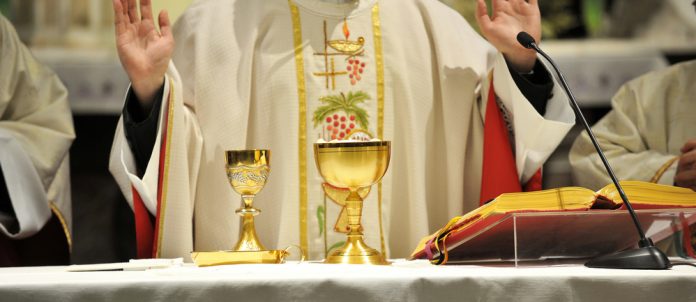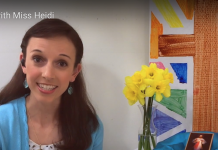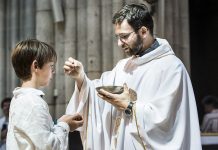
DEBORAH McCANN
The second half of the Mass, the Liturgy of the Eucharist is short—but so very full of meaning! We watch the priest do simple, everyday things: He sets out the table covering, he accepts the gifts of bread and wine, he pours the wine into several cups, and he washes his hands. Then he invites us to stand and pray. We pray together that God will accept what we have brought back to the table, and we conclude this part of the Mass with a rousing chorus of “Holy, holy, holy!”
Sometimes we only see the priest raise the bread and wine in blessing because we’re singing a hymn, but be sure to point out to your children what’s going on. The priest begins the blessing of the bread by saying, “Blessed are you, Lord God of all creation.” If we’re not singing, our response is “Blessed be God forever.” When he raises the chalice of wine, he again says, “Blessed are you, Lord God of all creation,” and we again reply “Blessed be God forever.” (You might ask the children to notice how often during this short part of the Mass the priest and people use some form of the word bless.)
Children love secrets. This would be a wonderful time to go deeper into this prayer by sharing the words the priest says privately. After blessing the bread, he says, “By the mystery of this water and wine may we come to share the divinity of Christ who humbled himself to share in our humanity.” After blessing the wine, he says, “With humble spirit and contrite heart may we be accepted by you, O Lord, and may our sacrifice in your sight this day be pleasing to you, Lord God.”
What powerful and transformative words! On our behalf, the priest is asking that we may, through this offering of the most basic elements of our food and drink, be considered worthy of becoming more like God—to actually share in his divine nature! And we do this with heads held high and eyes wide open—offering our very selves to God. Our singing of the “Holy, holy holy” at the end of the preface is an affirmation that we are ready to take the next step into the most profound prayer of the Mass.
Activity: Making Blessings
Have children trace their hands on pieces of colored construction paper and cut out the tracings. Then have each child come forward to a large poster board on which you have placed a cutout of a large basket. Write in large letters at the top of the poster board, “Make Us a Blessing, Lord!” Have each child write on the hand cutout a way they can be blessing for others that will help them act more like Jesus, such as “I can be a blessing by…cleaning my room, helping my sister with her homework, being kind to a grouchy neighbor,” etc. Have the child read aloud what they’ve written, and have everyone respond, “Make….a blessing, Lord,” while you glue the handprint (blessing side down) onto the basket. When you’re done, you’ll have a wonderful “blessing poster” to hang in the classroom.
Deborah McCann is a pastoral associate at St. Mary Star of the Sea in New London, Connecticut. She is the author of Lift Up Your Hearts: 50 Blessings and Prayers for Parish Meetings and Ministries (Twenty-Third Publications).
This article was originally published in RTJ’s creative catechist.
Image credit: peacepix, Shutterstock




